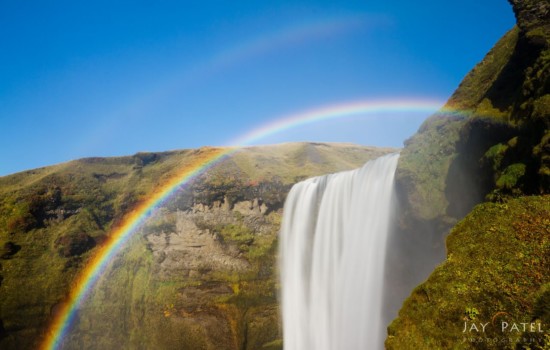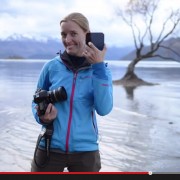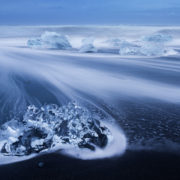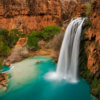Overcoming Challenges of ND Filters in Long Exposure Photography
If you check any landscape photographer’s bag, I’ll bet you’ll find at least one neutral density (ND) filter. ND Filters are a creative tool for long exposure photography. Essentially, an ND filter is a dark piece of glass in a neutral color which blocks light from entering your lens. Think of ND filters as a pair of sunglasses for your camera. This darkening of the scene allows the camera’s shutter to stay open longer. The increased exposure time creates that smoothing effect for anything moving in the scene, from clouds to water. There it is, the secret to creating a dreamscape of an image. Actually, that is only half the secret. The other half is knowing how to handle a few of the issues which pop up when using ND filters.

Nature Photography of Autumn Waterfall where Chrissy Donadi used a Circular Polarizer and ND Filters to capture a long exposure image.
While ND filters are the best tool to help a photographer create images with a peaceful and ethereal appeal, they do present their own set of mini challenges. The good news is that these issues are easily overcome with a little know-how and preparation. Below is my advice for identifying and overcoming these 5 common ND filters challenges so your time in the field is as peaceful as the images you bring back.
#1: Camera Shake
Since the purpose of an ND filter is to increase the exposure time, there is a very real possibility of camera shake. Camera shake is when the camera moves causing the image to unintentionally blur. This often happens when you shoot hand-held or the camera isn’t securely setup. To avoid this unwanted blur, be sure your camera is on a sturdy tripod. At the very least, setup your composition on something solid, such as a stone wall or your camera pack, to minimize as much movement as possible. This isn’t perfect but paired with the additional tips below it just might work.
When shooting on a tripod, be sure to turn off your camera’s image stabilization (IS). It is a common myth that one should always have the IS turned on. Then if you need IS, it will turn on and help your image. Particularly for nature photography, that is a myth which needs to be busted. IS only allows you to capture images of static subjects at slower speeds, moving objects will be just as blurry and in some cases even blurrier.
By its own nature, image stabilization is using motion to counter any camera movement. When you mount your camera on a tripod and keep the IS feature on, there is a risk of creating a feedback loop. The camera’s IS system detects its own vibrations and starts making adjustments. It can do this even if the tripod keeps the camera completely still. Thus, it introduces unintentional blur. The sharpest images come from a camera mounted on a sturdy tripod with the image stabilization turned off.

Long Exposure Photography of Patagonian Sunset with Circular Polarizer and ND Filters by Chrissy Donadi
Moreover, it may seem trivial but pressing the shutter button also produces tiny vibrations that often impact the image. There are a few options to avoid this camera shake. First, use a remote shutter release, which in a cord that plugs into the port of your camera. You press the button on the shutter release to capture the image without ever physically touching your camera.
If you do not have a remote shutter release, another option is to use the camera’s built-in self-timer. With many cameras, you can select whether you want 2, 5, 10 seconds of delay before the camera takes the photo. The benefit with timed delay is one less piece of gear to carry and use. However, the disadvantage of using a 2-second timer is losing control of the precise moment you want to capture the image. For example, when shooting waves, you often want to have more control at the precise moment the shutter opens. For this reason, I always advocate investing and carrying a shutter release cable.
#2: Getting everything in sharp focus
Depending on the strength of the ND filter as well as the lighting conditions, the camera may not be able to achieve automatic focus. Less light means less information for the camera to work with when autofocusing. In some cases, Live View with exposure simulation can help with focusing.
More often than not, it is best to focus without the ND filter. To set focus, I will setup the camera on the tripod (attach the ND filter holder if using square filters). Then, I will check my composition and focus appropriately. Once the shot is in focus, I will switch to manual focus to lock the focus. This guarantees that the focus will not change unless I physically change it myself. Last, I will carefully slide the ND filter into the holder, adjust the settings for a proper exposure accounting for the ND filter, and take the shot.
#3: Avoid vignetting with ND Filters
One of the most common issues when using filters is vignetting. Vignetting is an angle of view issue where there is a darkening of the corners of the image. Normally, vignetting will occur when you are using a wide-angle lens as well as when you are stacking multiple filters on the lens. There are a few ways to tackle this issue. First, as a general rule of thumb for vignetting and other issues, try to avoid unnecessarily stacking filters. Second, if the composition permits, simply zoom in with the lens until the vignette is gone. That is the simplest way to fix the problem in the field.
For the scenes which require every extra millimeter of that wide-angle lens, vignetting will need to be corrected in post. A first step is to use the Lens Corrections Panel in Lightroom’s Develop Module. A second step is to use spot removal tool to heal the area in Lightroom or the content aware feature in Photoshop. This could get tricky depending on the composition. Typically, these tools work well if the corners of the image are sky, grass, rocks, water, etc. It is good practice to be mindful of the corners of the image and know what will and will not be easy for the software to handle.
#4: Prevent light leak with long exposures
Light seeping into the camera is a common occurrence in long exposure photography. It often appears as streaks, banding, or color casts on the image. The stronger the ND filter used, the more susceptible your camera’s sensor becomes to unwanted light creeping in through the viewfinder eyepiece. In addition, light can creep into your camera through any ports and doors on the camera body. It can also seek through the gaps between your lens and the filter(s).
While light can seep in from a variety of places during long exposure photography, avoiding unwanted light is straight-forward. If possible, move your camera and shoot from a shaded spot or wait for clouds to cover the sun. This reduces the amount of light hitting your camera directly. These are three good practices in helping overcome light leak in the field.
Cover the Viewfinder Eyepiece Opening
Since changing your location or the weather isn’t always possible, the next step is to block any ambient light from the viewfinder eyepiece. Some camera brands have caps or shutters either attached to the strap or built into the camera body. If your camera does not have this feature, apply a piece of gaffer tape over the eyepiece works. Personally, I prefer gaffer tape over other tapes since it does not leave residue on your equipment.
Cover Any Ports or Doors
If you cover the viewfinder eyepiece and still notice artifacts on your image, try also covering any ports or doors with gaffer tape. For example, if you are using a shutter release cable, light may be getting in through that port.
Cover Any Filter Openings
Another issue could be the area between your filter holder and camera lens. Unwanted light can easily find its way into the camera with square photography filters because of the distance between the filter and the lens. Truth be told, almost any square filter leaks light when the filters are stacked. First, ensure that your ND filter is in the closest slot to the lens, minimizing the distance between the filter and the lens. The more distance between the filter and the lens risks reflections and light leaking behind the ND filter. Next, cover the top and sides of the filter(s) and holder with gaffer tape, a lens cloth, or a hat. Use anything that you have on-hand to block the light from that area.
#5: Remove color cast from ND filters
One last challenge to consider is color casting from ND filters. Most ND filters, especially strong ones, will have some sort of color casting. There are some brands which do not have color casting; however, those filters are quite expensive. Since filters are something that you typically keep through the life of your camera, it is worth the research and investment to find what works best for you and at your price point. Review manufacturer’s websites, research various professional photographers for their preferences, and make your own informed decision.
So generally speaking, an ND filter is going to have some sort of color casting. Thankfully, there are a few quick ways to fix color casting in post-processing. The easiest way to adjust the color cast if you have something white in the image is with the white balance tool.
If there is nothing white in your image, then you can adjust your whites in Lightroom just until the histogram starts touches the right-hand side. Finally, you can manually adjust your temperature and tint sliders until the color cast is removed.
If you are having trouble correcting color cast with the method above or really want to find a more technical solution for stronger ND filters, there is something to try. Find a white wall or backdrop that is neutral. Set up your tripod with your camera on a manual white balance (not auto) setting and take your test shot of the wall. Next, put on your ND filter and take a second shot adjusting shutter speed to have a proper exposure. With the two photos in Lightroom, you can adjust the temperature and tint for the second ND filter shot until it matches the first test shot. With that information, you know that your 10 Stop ND filter requires you to add or subject those temperature and tint adjustments to account for the color cast.
There it is. You have all the secrets and lessons learned on how to successfully use ND filters in the field to create dreamy water cascades and wind-swept clouds. Go forth and capture those calming and ethereal nature images with your ND filters because I think we all could use some more moments of zen in our lives. Happy Shooting!













I carry a small piece of soft black leather (~4″x6″) to drape over the eyepiece area. Much faster and less hassle than trying to keep that little Nikon eyepiece cover from dropping in the grass or water when installing or removing. A piece of black velvet would work just as well.
Great idea Owen! Provided the wind isn’t too strong, occassionally I just cover the opening with a lens cloth. It doesn’t matter the tool, as long as it works!